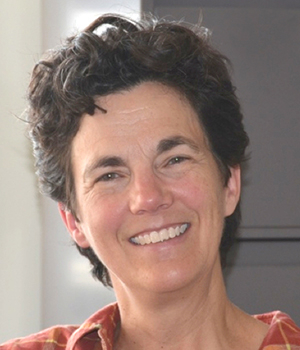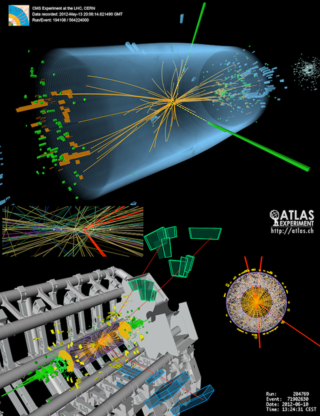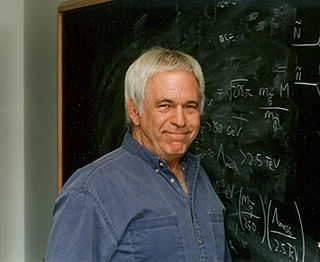Related Research Articles

In particle physics, a Grand Unified Theory (GUT) is a model in which, at high energies, the three gauge interactions of the Standard Model comprising the electromagnetic, weak, and strong forces are merged into a single force. Although this unified force has not been directly observed, many GUT models theorize its existence. If the unification of these three interactions is possible, it raises the possibility that there was a grand unification epoch in the very early universe in which these three fundamental interactions were not yet distinct.

The Standard Model of particle physics is the theory describing three of the four known fundamental forces in the universe and classifying all known elementary particles. It was developed in stages throughout the latter half of the 20th century, through the work of many scientists worldwide, with the current formulation being finalized in the mid-1970s upon experimental confirmation of the existence of quarks. Since then, proof of the top quark (1995), the tau neutrino (2000), and the Higgs boson (2012) have added further credence to the Standard Model. In addition, the Standard Model has predicted various properties of weak neutral currents and the W and Z bosons with great accuracy.

Technicolor theories are models of physics beyond the Standard Model that address electroweak gauge symmetry breaking, the mechanism through which W and Z bosons acquire masses. Early technicolor theories were modelled on quantum chromodynamics (QCD), the "color" theory of the strong nuclear force, which inspired their name.

In the Standard Model of particle physics, the Higgs mechanism is essential to explain the generation mechanism of the property "mass" for gauge bosons. Without the Higgs mechanism, all bosons (one of the two classes of particles, the other being fermions) would be considered massless, but measurements show that the W+, W−, and Z0 bosons actually have relatively large masses of around 80 GeV/c2. The Higgs field resolves this conundrum. The simplest description of the mechanism adds a quantum field (the Higgs field) which permeates all of space to the Standard Model. Below some extremely high temperature, the field causes spontaneous symmetry breaking during interactions. The breaking of symmetry triggers the Higgs mechanism, causing the bosons it interacts with to have mass. In the Standard Model, the phrase "Higgs mechanism" refers specifically to the generation of masses for the W±, and Z weak gauge bosons through electroweak symmetry breaking. The Large Hadron Collider at CERN announced results consistent with the Higgs particle on 14 March 2013, making it extremely likely that the field, or one like it, exists, and explaining how the Higgs mechanism takes place in nature. The view of the Higgs mechanism as involving spontaneous symmetry breaking of a gauge symmetry is technically incorrect since by Elitzur's theorem gauge symmetries can never be spontaneously broken. Rather, the Fröhlich–Morchio–Strocchi mechanism reformulates the Higgs mechanism in an entirely gauge invariant way, generally leading to the same results.

In theoretical physics, the hierarchy problem is the problem concerning the large discrepancy between aspects of the weak force and gravity. There is no scientific consensus on why, for example, the weak force is 1024 times stronger than gravity.
The Alternative models to the Standard Higgs Model are models which are considered by many particle physicists to solve some of the Higgs boson's existing problems. Two of the most currently researched models are quantum triviality, and Higgs hierarchy problem.

In particle physics, SO(10) refers to a grand unified theory (GUT) based on the spin group Spin(10). The shortened name SO(10) is conventional among physicists, and derives from the Lie algebra or less precisely the Lie group of SO(10), which is a special orthogonal group that is double covered by Spin(10).
In theoretical physics, dimensional deconstruction is a method to construct 4-dimensional theories that behave as higher-dimensional theories in a certain range of higher energies. The resulting theory is a gauge theory whose gauge group is a direct product of many copies of the same group; each copy may be interpreted as the gauge group located at a particular point along a new, discrete, "deconstructed" (d+1)st dimension. The spectrum of matter fields is a set of bifundamental representations expressed by a quiver diagram that is analogous to lattices in lattice gauge theory.
The J. J. Sakurai Prize for Theoretical Particle Physics, is presented by the American Physical Society at its annual April Meeting, and honors outstanding achievement in particle physics theory. The prize consists of a monetary award (US$10,000), a certificate citing the contributions recognized by the award, and a travel allowance for the recipient to attend the presentation. The award is endowed by the family and friends of particle physicist J. J. Sakurai. The prize has been awarded annually since 1985.

Ann Elizabeth Nelson was a particle physicist and professor of physics in the Particle Theory Group at the University of Washington from 1994 until her death. Nelson received a Guggenheim Fellowship in 2004, and she was elected to the American Academy of Arts and Sciences in 2011 and the National Academy of Sciences in 2012. She was a recipient of the 2018 J. J. Sakurai Prize for Theoretical Particle Physics, presented annually by the American Physical Society and considered one of the most prestigious prizes in physics.
Topcolor is a model in theoretical physics, of dynamical electroweak symmetry breaking in which the top quark and anti-top quark form a composite Higgs boson by a new force arising from massive "top gluons". The solution to composite Higgs models was actually anticipated in 1981, and found to be the Infrared fixed point for the top quark mass.
In particle physics and string theory (M-theory), the ADD model, also known as the model with large extra dimensions (LED), is a model framework that attempts to solve the hierarchy problem. The model tries to explain this problem by postulating that our universe, with its four dimensions, exists on a membrane in a higher dimensional space. It is then suggested that the other forces of nature operate within this membrane and its four dimensions, while the hypothetical gravity-bearing particle graviton can propagate across the extra dimensions. This would explain why gravity is very weak compared to the other fundamental forces. The size of the dimensions in ADD is around the order of the TeV scale, which results in it being experimentally probeable by current colliders, unlike many exotic extra dimensional hypotheses that have the relevant size around the Planck scale.

The Higgs boson, sometimes called the Higgs particle, is an elementary particle in the Standard Model of particle physics produced by the quantum excitation of the Higgs field, one of the fields in particle physics theory. In the Standard Model, the Higgs particle is a massive scalar boson with zero spin, even (positive) parity, no electric charge, and no colour charge that couples to mass. It is also very unstable, decaying into other particles almost immediately upon generation.
In particle physics, W′ and Z′ bosons refer to hypothetical gauge bosons that arise from extensions of the electroweak symmetry of the Standard Model. They are named in analogy with the Standard Model W and Z bosons.
Standard-Model Extension (SME) is an effective field theory that contains the Standard Model, general relativity, and all possible operators that break Lorentz symmetry. Violations of this fundamental symmetry can be studied within this general framework. CPT violation implies the breaking of Lorentz symmetry, and the SME includes operators that both break and preserve CPT symmetry.

Gordon Leon Kane is Victor Weisskopf Distinguished University Professor at the University of Michigan and director emeritus at the Leinweber Center for Theoretical Physics (LCTP), a leading center for the advancement of theoretical physics. He was director of the LCTP from 2005 to 2011 and Victor Weisskopf Collegiate Professor of Physics from 2002 - 2011. He received the Lilienfeld Prize from the American Physical Society in 2012, and the J. J. Sakurai Prize for Theoretical Particle Physics in 2017.
In theoretical physics, a mass generation mechanism is a theory that describes the origin of mass from the most fundamental laws of physics. Physicists have proposed a number of models that advocate different views of the origin of mass. The problem is complicated because the primary role of mass is to mediate gravitational interaction between bodies, and no theory of gravitational interaction reconciles with the currently popular Standard Model of particle physics.
In particle physics, composite Higgs models (CHM) are speculative extensions of the Standard Model (SM) where the Higgs boson is a bound state of new strong interactions. These scenarios are models for physics beyond the SM presently tested at the Large Hadron Collider (LHC) in Geneva.

Riccardo Rattazzi is an Italian theoretical physicist and a professor at the École Polytechnique Fédérale de Lausanne. His main research interests are in physics beyond the Standard Model and in cosmology.

In the terminology of quantum field theory, a ghost, ghost field, ghost particle, or gauge ghost is an unphysical state in a gauge theory. Ghosts are necessary to keep gauge invariance in theories where the local fields exceed a number of physical degrees of freedom.
References
- ↑ Weinberg, Steven (1972-12-18). "Approximate Symmetries and Pseudo-Goldstone Bosons". Physical Review Letters. 29 (25): 1698–1701. Bibcode:1972PhRvL..29.1698W. doi:10.1103/physrevlett.29.1698.
- ↑ Georgi, Howard; Pais, A. (1974-07-15). "Calculability and naturalness in gauge theories". Physical Review D. 10 (2): 539–558. Bibcode:1974PhRvD..10..539G. doi:10.1103/physrevd.10.539.
- ↑ Georgi, Howard; Pais, A. (1975-07-15). "Vacuum symmetry and the pseudo-Goldstone phenomenon". Physical Review D. 12 (2): 508–512. Bibcode:1975PhRvD..12..508G. doi:10.1103/physrevd.12.508.
- ↑ Arkani-Hamed, Nima; Cohen, Andrew G.; Georgi, Howard (2001). "Electroweak symmetry breaking from dimensional deconstruction". Physics Letters B. 513 (1–2): 232–240. arXiv: hep-ph/0105239 . Bibcode:2001PhLB..513..232A. doi:10.1016/s0370-2693(01)00741-9. S2CID 7557362.
- ↑ Arkani-Hamed, Nima; Gregoire, Thomas; Wacker, Jay G; Cohen, Andrew G (2002-08-13). "Phenomenology of Electroweak Symmetry Breaking from Theory Space". Journal of High Energy Physics. 2002 (8): 020. arXiv: hep-ph/0202089 . Bibcode:2002JHEP...08..020A. doi: 10.1088/1126-6708/2002/08/020 .
- ↑ Arkani-Hamed, Nima; Cohen, Andrew G; Katz, Emanuel; Nelson, Ann E (2002-07-12). "The Littlest Higgs". Journal of High Energy Physics. 2002 (7): 034. arXiv: hep-ph/0206021 . Bibcode:2002JHEP...07..034A. doi: 10.1088/1126-6708/2002/07/034 .